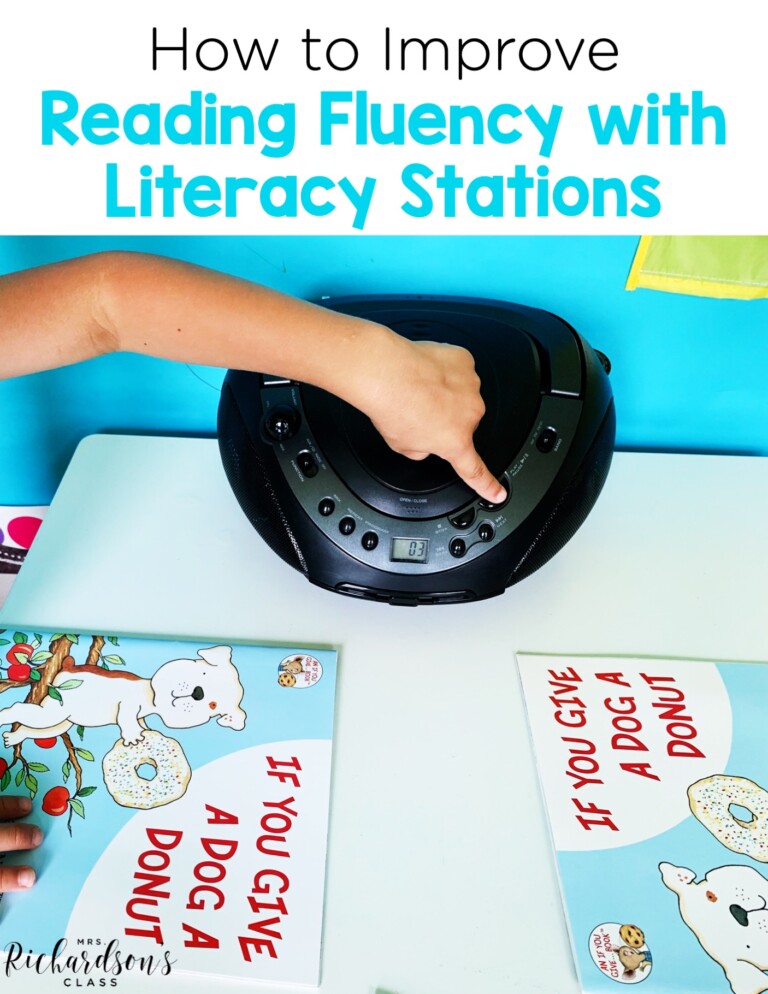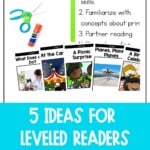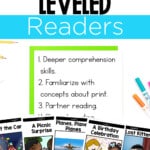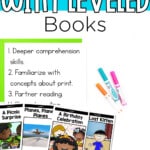


We’ve all learned so much now that the science of reading research has come to light in the past few years. We’ve learned that our young readers need explicit and frequent phonics instruction. We also learned that our approach to reading small groups needs changes like how we prompt our readers and how we assess their reading. With all of this knowledge, what do we do with leveled readers?
Should we throw them out? Do we remove them from our literacy libraries? Do they even serve a purpose in the kinder, first, and second grade classrooms? Well, friend, I’m here to tell you that I think they do. While our approach to reading small groups has changed, leveled readers can still benefit our students, especially when they have strong decoding skills in their toolbelt.
Because they don’t have to be as conscious about word choice, you are able to not only use more natural language but also the storylines can lend themselves to be deeper in meaning.
For example, you can have students focus more on story elements and map a story in fiction leveled readers. Building strong comprehension skills ultimately leads to better reading. These are great for our strong decoders in first and second grade.
Hear me clear: Do not use them IN PLACE OF DECODABLE READERS for early readers; instead, use them with your students who are still working on grasping how print works. Left to right directionally, return sweep, where a sentence begins, where the story begins, and where it ends. Concepts of print are valuable skills our young readers need to learn and apply.
Leveled readers are great to use in the classroom in partner reading. You can do this in literacy centers, as morning work, or if you find yourself with a few extra minutes. It also helps build classroom community. Reading aloud with a partner can also improve reading fluency, too!
Shared reading is when the teacher and students read together. The teacher models and the students practice decoding strategies, comprehension strategies, and phonics skills in authentic ways. It also increases fluency. Finally, a shared reading approach with leveled readers can help you see where kids are still struggling
Using leveled readers, especially nonfiction ones, can help your students build background knowledge on science, social studies, and even math topics. This can include information and facts about a topic and new vocabulary to learn.
You may have students who are strong decoders and are ready to move towards leveled books to dive deeper into comprehension skills. Maybe you’re required to use leveled readers by your school or district. No matter the reason, if you’re looking for leveled books that have been updated to better align with the science of reading research, I can help.
The Guided Reading Kits for Levels A-M have everything you need for your reading small groups. Each level includes:
They have been updated to reflect the best teaching practices with the science of reading in mind with components like prompting guides, decoding strategies, high-frequency word instruction, and more!
You can find the bundles of leveled kits here: Kindergarten (Levels A-D), First Grade (Levels E-J), and Second Grade (Levels K-M).
Just remember to use the best books, decodable or leveled, for the readers in your classroom. With assessments and observations, you’ll be able to see when your students are ready to move toward leveled books. In the meantime, try using them for one of my suggestions above. Let me know how it goes!

Want to use the latest research to boost your readers during small groups? This FREE guide is packed with engaging ideas to help them grow!

I’m a K-1 teacher who is passionate about making lessons your students love and that are easy to implement for teachers. Helping teachers like you navigate their way through their literacy block brings me great joy. I am a lifelong learner who loves staying on top of current literacy learning and practices. Here, you’ll find the tools you need to move your K-2 students forward!


| Cookie | Duration | Description |
|---|---|---|
| cookielawinfo-checkbox-analytics | 11 months | This cookie is set by GDPR Cookie Consent plugin. The cookie is used to store the user consent for the cookies in the category "Analytics". |
| cookielawinfo-checkbox-functional | 11 months | The cookie is set by GDPR cookie consent to record the user consent for the cookies in the category "Functional". |
| cookielawinfo-checkbox-necessary | 11 months | This cookie is set by GDPR Cookie Consent plugin. The cookies is used to store the user consent for the cookies in the category "Necessary". |
| cookielawinfo-checkbox-others | 11 months | This cookie is set by GDPR Cookie Consent plugin. The cookie is used to store the user consent for the cookies in the category "Other. |
| cookielawinfo-checkbox-performance | 11 months | This cookie is set by GDPR Cookie Consent plugin. The cookie is used to store the user consent for the cookies in the category "Performance". |
| viewed_cookie_policy | 11 months | The cookie is set by the GDPR Cookie Consent plugin and is used to store whether or not user has consented to the use of cookies. It does not store any personal data. |


